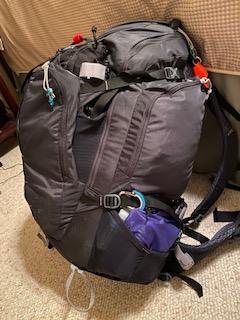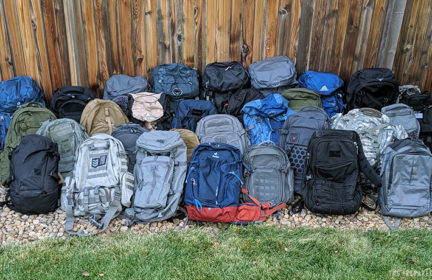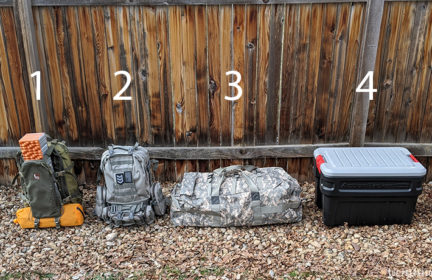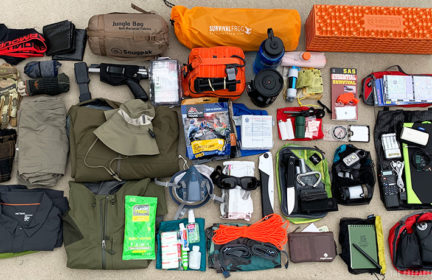What do you think about a modular bug out bag?
I’m trying to create the perfect system for a bug out bag and was wanting some advice. So tear this apart and let me know what you think. Am I onto something here? Or is there something I’m overlooking that will get me killed?
The Problem:
Current bug out bag recommendations from places I’ve seen tend to lean a bit to the ‘bug out to the woods’ side of things. But I’m thinking that if a hurricane is coming my way, I am more likely to bug out to a hotel in a neighboring city. But then I don’t want to only have a bug out bag set up for hotel living and if a different disaster comes where I do need to bug out to the woods, then I don’t want to have to be rearranging my entire bag to be able to survive that way.
My crazy hair-brained scheme:
I’m thinking about creating a modular bug out bag system. I’ll have my main pack with essentials like toiletries, map, water filtration, and more. But then I’ll have different modules next to it that I can quickly add to my main pack according to the disaster I’m bugging out to. For example, lets say I’m bugging out to a hotel and the weather is on the colder side of the year. I would then grab my hotel module and my cold weather module and stick it in the bag and go.
These modules can be color coded and/or labeled with big pictures of what they are used for and be something simple like a gallon waterproof plastic bag or a small case.
Why this might work:
I know that time is of the essence, but I don’t think that an additional minute of grabbing a module, putting it in the bag, and zipping the bag shut will be that critical. And with this design, I won’t be carrying unnecessary things that I don’t need and have the perfect load out for my situation. I’m not going to be carrying around fire starting and cooking stuff if I’m bugging out to a hotel, or carrying USB cables and other plushy things that would be useless in a camping scenario.
-
Comments (29)
-
Bob - May 23, 2021
Good afternoon Peter 44,
Per theme’s overall question: I use the modular system. (Do be careful; nothing is perfect, especially in re emergencies and disasters.)
A solution to “the problem”; Avoid the gimmicks and pre-made kits like “JUDY”. Go to the top of the forum and at “Kits” spend some time studying the material. Return to forum for clarifications needed.
For my modular system’s philosophy, I inject the term “common denominators”. If, for example, you’re evacuating to a hotel, you still need a first aid kit (IFAK = Individual First Aid Kit) tailored to your known specific needs. Are you blister-prone, Do you require a routine RX pharma ? Etc.
Your scheme is not crazy. Believe the US Army patented their “MOLLE” (Modular Lightweight Laddder System). One aspect of modular systems for private citizen preppers is the cold weather clothing and the warm weather clothing. Look for common denominators – even create some such as always wear wool socks. Hurricanes mentioned above; rubber boots an evac requirement.
I personally do not use a back pack.My system uses some cargo vests I’ll be wearing and load-bearing suspenders attacked to a belt and this rig is loaded with pouches and some thin lightweight tarps lashed to the suspenders’ “H” section on back. Depending on my evac specifics, will have a flight bag with some water and well-packed foods not requiring preparation. There are hotels with more bugs than out in the fields or forest. Thus “well packed”.
Do spend some time reflecting on – and spending some time here at forum – in re various evacuation scenes. The hotel might automatically be allocated for responders arriving from out of the disaster area. The hotel might have new storm damage closing a group of rooms, etc. Disasters involve rapidly changing circumstances and this means adjusted plans.
-
Bradical - May 23, 2021
Run some drills. Write down possible scenarios you might find yourself in and put them in a hat. Draw one out of the hat and time yourself to see how quickly you are able to get out the door with all your gear. See if that is a responsible response time for yourself.
One possible issue I can see is having your bag uncomfortable. If you have these so called modules in a case, placing two cases in the top of your bag isn’t going to be very comfortable and the weight might not be as balanced as you might like. You can probably get all your stuff you need in the pack, but now you have to hike out with it.
-
Alisa Felix - June 12, 2021
That would be fun to run some drills and get some practicing in
-
-
Scott P - May 24, 2021
I personally would be cautious about over optimizing the primary kit. You might plan on going to a hotel, but instead end up in the woods, or a large evacuation shelter and wish you had some of your other items. For me making the main kit universally applicable but not necessarily optimized is key, that way it is easier to adapt to the situation. And then throughout the seasons add and subtract sessional items as appropriate. Having secondary add ons isn’t a bad idea, as long as your main kit hasn’t removed your ability to handle a wide range of situations. For example still having a lighter, a contractor bag and cordage for fire and shelter even though you might have a secondary kit with a tent and sleeping bag.
Another thought on mentioning the USB cords as a plushy add-on, my main kit has the means to keep my phone charged (power bank, solar panel, charging cable) and also an OTG adapter and a USB drive with useful and not so useful books in PDF form. The phone is a great tool, and having a bunch of books will be nice for the amount of hurry up and wait that can happen in a survival situation, even in the woods.
But like others have said run scenarios. Train with your primary pack, go into the woods and spend the night. Set up in a garage for the night like if you were in an evacuation shelter like a school or community center.
-
Peter 44 - May 24, 2021
You make some good points here. You can never plan 100% for every situation. I could be evacuating out to a hotel but they are all full and now I have to camp out on the lawn.
Thanks for your suggestion to make my pack mostly versatile but then have small secondary add-ons. This is probably what I’ll end up doing.
-
-
RedneckContributor - May 24, 2021
I don’t care for your idea of sticking different modules in your main bag. That suggests all modules are exactly the same size and that isn’t logical. A winter module would have to be bigger than a summer module. A camping in the woods module would be bigger than head to a motel module.
If you were to do this, I’m with Bob and would use MOLLE bags as opposed to modules that go inside. I use a MOLLE bag on my get home bag. This way, you can have different sized external MOLLE bags depending on the situation, and they could be different colors. My default layout would be emergency bug out into the woods. If a hurricane approaches, you have plenty of time to reconfigure.
-
Josh CentersContributor - May 24, 2021
My ILBE bug out bag is modular. Cumbersome when fully assembled, but modular.
-
Peter 44 - May 24, 2021
That does look very modular, but I can’t believe that guy in that one picture on your review with like 5 backpacks strapped to the outside of his backpack hasn’t tipped over. That’s a lot of weight to be away from your body.
-
Josh CentersContributor - May 24, 2021
We’re very stout here at The Prepared.
-
-
Henry Tubbs - May 25, 2021
I avoid a modular system and opt into getting my hands down into my bag more often. Every three months I pull everything out and do a check of what is relevant, what is expired, and what needs replaced.
The more often I get in there the more familiar I am with what I have.
-
Alicia - June 3, 2021
After starting this response, I realized that I do a form of modular packing with the BOB as the foundation – start with it and add on. This is a bit different than the priority bag system mentioned here. The BOB is easy to find and take in the car which is the first step to bugging out in nearly all of my known scenarios. I also am familiar with its contents and know it is for basic needs – doesn’t cover many scenarios that are less dire. For example, when I evacuated for a fire, I still had to go to work, and I don’t have extensive toiletries or work attire in my BOB. So I had to pack for that scenario and had some lead time to do so only because I was vigilant and acted early. I keep my normal travel toiletry kit at the ready so you could say I have a travel/toiletries module. I also organize the inside the BOB with packing cubes that are color coded for different functions so it’s easier to find and also jettison if not needed and I’m forced to be on-foot (a different type of modular). As others have mentioned, this makes adapting to changing situations more supportable. My BOB contains food that in the hotel scenario you may have skipped. From traffic delays or just exhaustion from stress and packing, you may be really happy to have that food with you in the hotel. And given a hurricane remains a strong storm in a vast area, the hotel may lose power and you’ll have a light source with you.
-
Bob - June 3, 2021
Good afternoon Alicia,
I like your use of color-coded “cubes” per function.
(Not sure what “cubes” means.)
I’m also an avid believer of color coding.
-
Alicia - June 3, 2021
My reply here didn’t post either. Hmmm. Then it did so I deleted it to reduce the duplication. The items I used are actually called packing cubes. Here’s a link to what I use. The manufacturer, Eagle Creek, started this concept and has discontinued this particular model, Specter. Their new models have fewer colors.
-
Bob - June 3, 2021
Good afternoon Alica,
Thank you for the clarificating info and link.
They are somewhat expensive. I use Army, FEMA, acculumated oil industry stuff and handouts from medical, dental fairs I do volunteer work at. All no cost.
My only “cube” that I bought was a 7X10X5 soft sided mini “ice chest” by Arctic Zone in case I wanted to carry some chilled something or other.
-
Alicia - June 4, 2021
They are pricey. I’ve found most items that are both lightweight and strong tend to be so. I have found some good prices on ebay and other sources.
-
Alicia - June 3, 2021
My photos didn’t post. Trying again.
-
Peter 44 - June 4, 2021
Do you find those packing cubes to be too bulky or oddly shaped so that it doesn’t conform to your body well?
That’s good to hear that you’ve actually used your bag before and it hasn’t just sat on a shelf.
-
Alicia - June 4, 2021
That’s exactly why I chose the Specter version. They are made of silnylon which is very thin, light and pliable (like a windbreaker) while still being strong and water repellent (zippers and seams are not sealed so not waterproof). The dry bag I have is seamed-sealed of the same material with a water proof closure. The blue in the lower side pocket (see photo above) is a sea-to-summit draw string bag that is also silnylon that contains the sanitation items: spade, wipes, travel TP roll. You can see how it’s conformed to the contents and not kept it from fitting into that small pocket.
-
Peter 44 - June 5, 2021
I’m going to look into those today. Thank you for your recommendations.
I also like your knife strapped to the side of your bag there. Looks heafty and sturdy.
-
Alicia - June 5, 2021
Eagle creek has stopped making the specter cubes. You’ll have to find some sellers on Amazon, ebay or other sites. REI has the specter Tech (fuller zipper with more subdued colors) on clearance. Also my source for the the Sea-to-Summit stuff and dry sacks. Regarding the knife: It is one area (of a few) that my husband has embraced in my prepping hobby/habit. He’s been following Survival Lilly and this is her APO-1. I got the budget one recommended at this site which I also liked which is now in our car GHBs. I’m finally entering my BOB into the Kit Builder and I’ll share it once I’m done.
-
Peter 44 - June 5, 2021
Those are some great prices for the specters on clearance, thank you for pointing those out.
Also thanks for the link to your knife and the prepared’s article about knives. This site has some good stuff, I need to spend more time reading the articles.
I appreciate all your help Alicia
-
-
Sun Yeti - June 10, 2021
I kind of do the inverse; I have a BOB with modules I can drop to save weight if I need to.
I figure it’s easier to drop 5 lbs out that I realize I don’t need and can’t carry on a long trek than to assembly the right mix of kits when I leave the house.
Also, I love the granite gear zipditty bags for modular packing. They come in a number of colors and are very lightweight silnylon.
-
Peter 44 - June 11, 2021
That is an interesting strategy. So what would be in some of the modules that you would toss first? I’m trying to wrap my head around which items I would think about putting in a bag that would be nice to have, but can toss if needs be.
-
Alicia - June 11, 2021
And this is the basis of the Levels in the BOB page . You could start with that. Because you will know the situation, weather, potential duration and what you actually had on your person, you can assess what you can likely live without: EDC redundant items like like multi-tool, extra glasses/sunglasses/etc; Reduce redundancies to single level for water, shelter, fire, etc; extreme weather support that is not anticipated – for over 100F or below 40F if your bag covers all weather conditions; shoes because you were wearing better ones. I think a few mental experiments with your most likely scenarios and time with your BOB can help you figure out what would make sense for you to stage for jettisoning as well as to stage (or at least list) for grabbing if you have time and are going by vehicle so weight/space is less of an issue.
-
Peter 44 - June 12, 2021
This actually makes a ton of sense now to pack heavy for many situations and then to dump things according to the situation you are bugging out from. Especially dumping EDC redundant items
-
Alicia - June 12, 2021
Indeed! The challenge is when there is little time and weight matters. My ‘lighter? Ha!’ BOB is still 40lbs and near bursting. Many clothing or other pliable items are stuffed into the small pockets of space between firmer items. Needing to jettison quickly would be a major challenge. I need to heed my own advice and do some experimentation, re-organization, and reduction. Thanks for the topic.
-
hikermor - June 12, 2021
I maintained a BOB-like bag for years before i heard the term, volunteering actively for search and rescue missions. We all soon learned that a bag, ready to go and well stocked with the basics, was a necessity. My bag, since I was an EMT, was quite heavy in first care material, esp.splints, BP cuff, and the like. I almost always included a sleeping bag, since we were often pulling all nighters, sometimes we got a chance to snooze. I came to realize that taking stuff out was a tricky proposition, since circumstances often change drastically
The BOB must be versatile and useful in a variety of situations. Recently we had to bug out – mandatory evac confronting a major fire, and we had no idea where we would be. Th remainder of the first night we snoozed in our vehicles; the rest of the time we were in a very decent motel, thanks to a kind relative – actually sort of a mini-vacation. But you never know precisely how these episodes will turn out
Your gear must answer basic needs, be as light as possible while still being useful. Versatility is a plus. A well maintained bag is changed as the seasons and circumstances vary. You must be able to operated at night and in very unusual conditions. you must be familiar with your gear and its function. There is no room in a BOB for instruction manuals, although they are good for lighting a fire….
-
Alisa Felix - June 12, 2021
You share like the perfect description of what a bug out bag should be. Thank you for taking the time to write this. It helps me to rethink my strategy and use case for my bag.
Being an EMT, is first aid a big part of your BOB?
-
-
Bob - June 12, 2021
Good morning,
Are we all using basic, common definitions of “BOB” – bug out bag and “main pack” ?
Personally, had considered the BOB to be the main pack for an evacuation.
An incident commander’s full loadout wheeled duffel is definitely NOT a BOB ! Extra boots and a floatation work vest outfitted with radios not needed but basic non-inflatable work vest (like a USCG type III) typical for here if evac route involves water crossings.
Overall load weight and volumn can be as critical as loaded stuff in BOB.
-
- News for the Week 2024-11-18 - 24 hours ago
- News for the Week 2024-11-4 - 6 days ago
- (Official discussion) Rainy day funds and cash on hand - 2 weeks ago
- News for the Week 2024-10-28 - 3 weeks ago
- News for the Week 2024-10-21 - 1 month ago
This forum is heavily moderated to keep things valuable to as many people as possible. Full community policies are here. The basics:
- 1. Be nice to each other.
- 2. Stay focused on prepping.
- 3. Avoid politics, religion, and other arguments.
- 4. No unfounded conspiracies, fake news, etc.
- 5. Debate ideas, not people.




